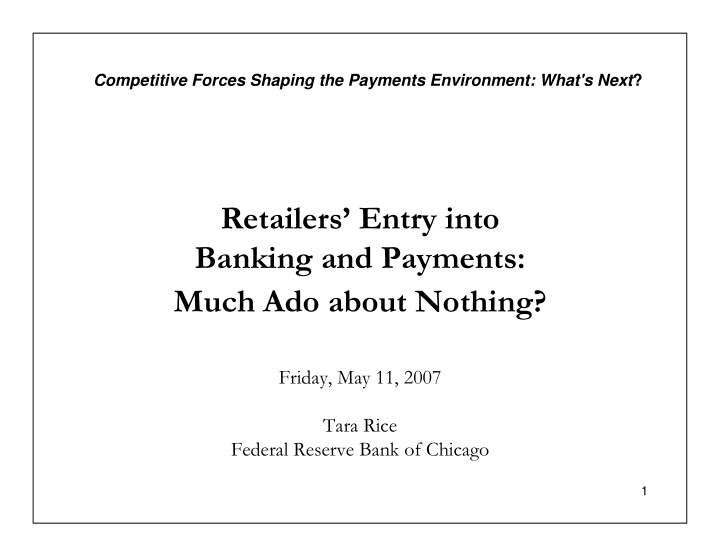



Competitive Forces Shaping the Payments Environment: What's Next ? Retailers’ Entry into Banking and Payments: Much Ado about Nothing? Friday, May 11, 2007 Tara Rice Federal Reserve Bank of Chicago 1
Panel Questions • What factors contribute to the success or failure of retail banking venture? • What are the advantages and disadvantages of a retail firm offering payment products to its customers? • Are alternative providers filling new niches or competing directly with banks for retail banking customers? 2
Reasons Retailers Want Entry to Banking • Process store payments made by their customers – Reduce costs of accepting payments • Offer customers additional products & services – Credit cards – Home mortgages and home equity lines of credit – Investment products – Transaction accounts 3
Reasons Banks Do Not Want Retailers in Banking • Reduces their revenues from payments processing – Merchant processing fees • Challenges the bank franchise (charter) – Its value lies in its exclusive right (ability) of final settlement of payment – Yet, is currently being encroached by third party payment providers • Large retailers (especially those with market power) pose additional threat to both 4
Reasonable Motivation By Both Parties? • Banks offer a comparative advantage in payments in many respects – Access to Federal Reserve operated payment systems – Trusted third-party guarantee – Expertise in financial risk taking – Soft-information collection (know your customer) and hard-information collection (know income and spending patterns) 5
Reasonable Motivation By Both Parties? • But banks also “outsource” or “offshore” a number of functions – Customer service (call centers) – Account servicing (lockbox, account reconcilement) – Loan production (mortgage processing) – Information technology (networks, software) – Credit history (credit scoring) – Currency (armored car carriers) – Check Processing (adjustments and exceptions) Bob Olson, from Carretek discussed “How Payments Offshoring Is Helping US Banks Execute Their Payments Strategies” at the Chicago Fed, November 16, 2006. 6
Retailers in the US • In the U.S., retailers have had to find creative alternatives to outright owning a commercial bank – Due to separation of banking and commerce activities, which has existed since 1787 • Solutions: – Cooperate with a payments provider • Open a bank branch in a retail outlet • Offer niche or limited payment services – Establish an Industrial Loan Corporation (ILC) or a Credit Card Bank (CCB) 7
U.S. Solutions: Industrial Loan Corp (ILC) • Only a small number of retailers own ILCs – Target • Or are awaiting approval – Home Depot • Wal-mart’s application brought issue to forefront – Current moratorium on ILC applications For more information see: Wilmarth. 2007. “Wal-Mart and the Separation of Banking and Commerce,” Conn Law Review 39 (April); Kaufman and Johnson. 2007. “A Bank by Any Other Name.” draft. 8
U.S. Solutions: Industrial Loan Corp (ILC) • Significant size differences between ILCs and Commercial Banks (CBs) • $213B in assets in ILCs • $8.9T in CBs ($11T in all banks) • Largest Commercial Banks: Bank of America ($1,084B), JP Morgan Chase ($653B), Citibank ($538B) • Largest ILCs: Merrill Lynch ($67B), UBS ($22B), American Express ($21B) • 52% of ILC assets in top 3, all financial firms • All ILCs account for < 2% of banking industry assets 9
U.S. Solutions: Credit Card Bank (CCB) • Retailers with CCBs: Sears, Circuit City, Harley- Davidson, Nordstrom, May Department Stores • Potential benefits to owning CCB: – Increase revenue with private-label cards (interest income) – Improve targeted sales efforts (direct mail campaigns) – Reduce cost of financing CC receivables (move to CCB) • No evidence of improved performance of retailers with CCBs, some negative results (longer collection periods, more receivables) Source: Nam, Gup, Kim, 2007. “The Financial Performance of Retailers Owning Credit Cards Banks,” International Journal of Revenue Management 1 (2). 18 CCBs studied. 10
Retailer solutions in the US • Retailers could have competitive advantage in: – Distributing goods (services) to a wide customer base (both demographically and geographically) – Providing new products – Offering competitive prices – But it is not obvious that these advantages would make retailers skilled at banking 11
Much ado about nothing? • Debate regarding retailers entry into payments • Would it result in: – Competition? • by competing in the same payments space, but without the potential regulatory oversight and without the experience and foundation in payments/banking activities – Cooperation? • by bringing new business/customers to banks, driving innovation and/or creating efficiencies by passing on their knowledge and advantages (i.e., running electronic networks, creating expansive distribution networks, branding and advertising) • Let’s ask our panelists… 12
Panelists • Steve Worthington – Professor of Marketing, Monash University, Faculty of Business and Economics – Retailer experience in the UK • Dave Martin – Executive Vice President and Chief Training Consultant, NCBS – In-Store branching • Hamed Shahbazi – Chairman & CEO, TIO Networks Corp. – Offering payment solutions to niche market 13
Recommend
More recommend